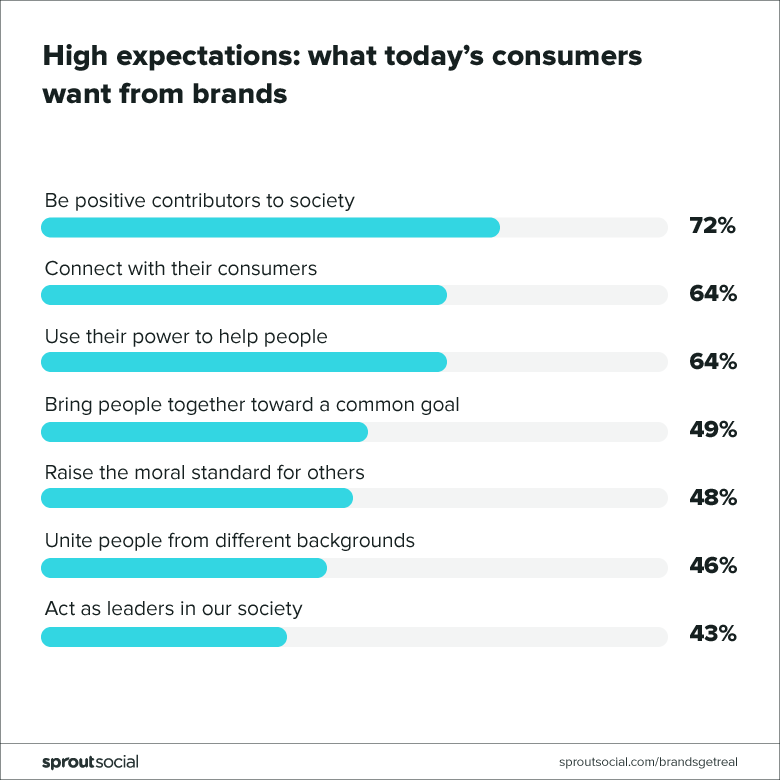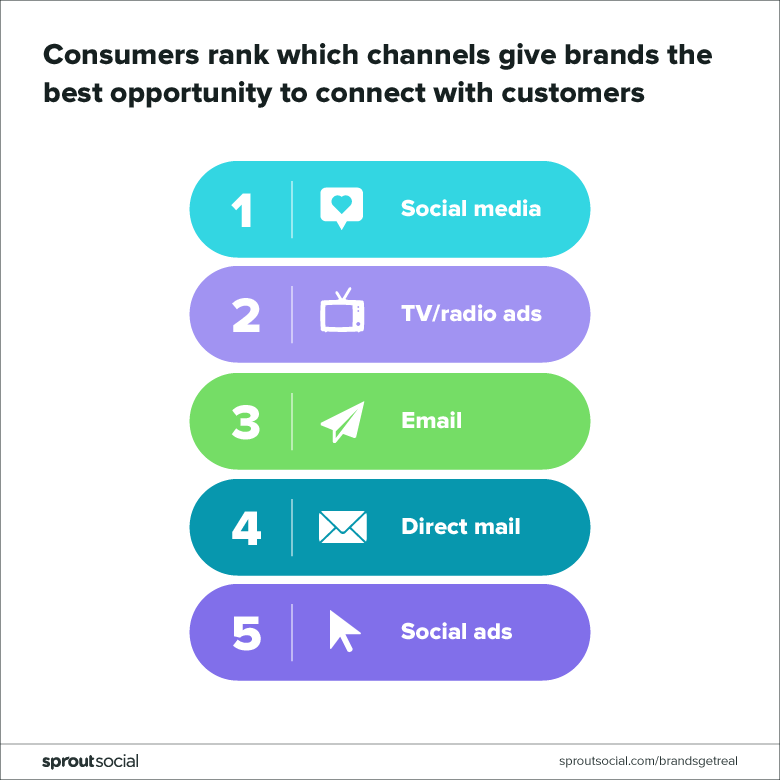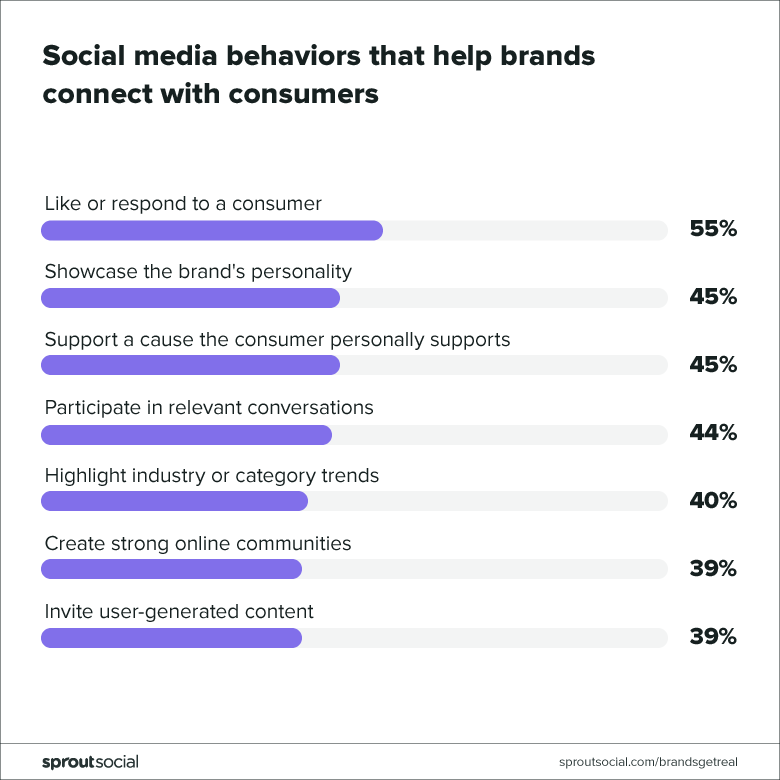#BrandsGetReal: What consumers want from brands in a divided society
Introduction
People today feel more divided than united—and it’s all too easy to see why.
Political discussions veer toward ‘right vs. wrong’ and ‘us vs. them.’ Sharing an opinion can quickly devolve into name-calling and fighting amongst friends who don’t see eye to eye. And online, this all happens at the speed of social.
New data from Sprout Social reveals that four out of five consumers believe society is more divided today than ever before. Asked what factors contribute to society’s fracturing, 72% point fingers at government and political leaders, and over half of consumers (55%) say social media is to blame.
But despite the negativity, people remain hopeful. Hopeful that social media, for all its flaws, can actually heal society’s divisions and reconnect people with one another. Ninety-one percent of consumers believe social can connect people, and 78% want brands to use social to bring them together. Unlike partisan public figures, brands find themselves uniquely positioned to foster connections between people online.
We surveyed more than 1,000 consumers to understand their desire for greater connection—with the brands they love and with each other—and how brands today benefit when they facilitate connection on social. This report explores why consumers see brands as ideal facilitators of connection and how brands can establish meaningful relationships with consumers by acting as connectors first and sellers second.
Key findings
Brands are no strangers to social. But, by and large, brands have only just begun to realize the value of truly connecting with consumers and treating social as more than a channel for promotion. Here are the top five findings from our research on the business value of building connections through social channels:
- People believe brands and social media can power connections. Despite feelings of division, 91% of people believe in social’s power to connect people. More specifically, 78% of consumers want brands to use social to help people connect with each other.
- Social is the number one channel for brands to connect with consumers. When asked which communication channels give brands the best opportunity to connect with their customers, survey respondents ranked social media as number one.
- Connection breeds loyalty and bottom line growth. Investing in relationships with consumers directly impacts business revenue and strengthens customer loyalty. When customers feel connected to brands, more than half of consumers (57%) will increase their spending with that brand and 76% will buy from them over a competitor.
- Real people are the key to authentic relationships. Consumers want to learn more about the people behind their favorite brands. Seventy percent of consumers, for example, report feeling more connected when a brand’s CEO is active on social. Additionally, 72% of consumers report feeling similarly when employees share information about a brand online.
- People want brands to connect them to other people. And they don’t mean only those with similar mindsets. Sixty-two percent believe social can unify people of different backgrounds and beliefs, and more than half (52%) expressed interest in connecting with individuals different from them.
Section 2
Connection is the new currency
Our newsfeeds today overflow with constant breaking news stories and examples of leaders pitting one group against another. All the political strife can make it a challenge to find a true connection. But while 72% of consumers cite government and political leaders as playing a significant role in dividing society, people have a much more favorable outlook when it comes to brands.
Their expectations for brands are high. Consumers expect brands to serve as connectors, whether that means fostering connection with their own customers or bringing together people with different perspectives. In fact, nearly two thirds (64%) of consumers want brands to connect with them, while just under half (49%) expect brands to bring people together toward a common goal.

But what defines a connection between a brand and consumers?
For starters, it’s not just about a brand’s popularity. Metrics like audience size and pageviews matter, but they say little about consumer sentiment or why someone stays loyal to a particular company. A growing number of followers, for example, doesn’t reveal why someone feels an attachment to a specific brand or if a shopper is truly loyal to one business over another.
When asked to reflect on their relationship with brands, two thirds of consumers equate feeling connected with trust. Furthermore, 53% of people say they feel connected when that brand’s values align with their own. And more than half (51%) say their relationship with a brand starts when they feel the brand understands them and their desires.

Of all the communication channels available to them, consumers point to social media as providing brands the greatest opportunity to truly connect with their audiences. Other effective channels for connection include TV/radio advertising, email and direct mail to consumers’ homes. Social ads round out the top five.

Social also gives brands the opportunity to connect people on opposite ends of the political spectrum. Seventy-two percent of consumers who identify as conservative want brands to use social to help individuals connect with each other; 85% of those who identify as liberal share the same desire.

Section 3
Brands are the new relationship experts
As the demand for connections grows stronger, consumers see brands in a new light. The brands emerging as leaders focus on building genuine relationships among their consumers, moving away from an emphasis on selling and further differentiating themselves from the competition.
Our research reveals that nearly four in five consumers (79%) agree brands are well positioned to connect people of varying backgrounds and beliefs—and for several reasons. Eighty-one percent of consumers say brands can be good connectors because they carry products and services that appeal to a diverse range of customers. And 58% make the case for brands as unifiers because they receive significant media coverage and attention.

So why do consumers rank social as the top channel for brands to use when connecting with their customers? It’s worth taking a broader look at how people view social and its impact on their lives. The majority of consumers believe social can bring people together, with 63% citing social’s ability to help people keep in touch, and 62% saying social unites people with different beliefs.
Based on personal experience, nearly half of consumers (46%) say social has introduced them to new people, while 44% say it has helped them understand a different point of view. As brands embrace their role as relationship builders, doubling down on social to power connections is the logical next step.

Consumers want brands to use social to help them connect with others for several reasons. More than half of consumers (55%) want brands to use social to help connect like-minded people with each other, while more than one third (36%) are looking for communities they can belong to. And over half of conservatives (51%) and liberals (54%) would like to connect with people who are different from them.

But why should brands care?
Simply put, connection breeds loyalty, protecting businesses from boycotts when customers have a bad experience, or from losing customers to a competitor. Sixty-four percent of consumers say that their loyalty to a brand increases when they feel connected.
Connection also directly impacts a brand’s bottom line. More than three quarters of consumers (76%) say they would buy from a brand they feel connected to over a competitor, and 57% say they are more likely to increase how much they spend with a brand when they feel connected. On the other hand, when consumers don’t feel connected to a brand, 70% are less likely to shop there over a competitor and almost two thirds (61%) will spend less with that business.

#BrandsGetReal: YouTube
YouTube, the global video-sharing platform, reaches more than one billion users every month. Recognizing the reach of its global influencers and creators, as well as the size of their potential audience, YouTube launched its Creators for Change program to build empathy and forge new connections among its users.
The program empowered people from all walks of life to connect with each other. Video simply provided the medium. With a platform to share personal stories with people of different backgrounds and beliefs, creators all over the world sparked conversations around topics like xenophobia and online extremism.
To supplement those narratives, YouTube creators also received the tools they needed to facilitate constructive dialogue around tough issues and to craft messages promoting social change. This campaign gave YouTube the opportunity to both address criticism related to the moderation of sensitive content on its platform and to put the focus on facilitating positive conversations. Since its inception, YouTube’s initiative has logged 60 million views and 731,000 hours watched of all Creators for Change videos.
Section 4
Real people drive real connections
For brands to build true connections with people, they need to meet consumers on their preferred communication channels and create content that puts a brand’s own people front and center.
But companies can’t tell the story of their people without a strong social foundation. According to our research, 65% of consumers feel more connected to brands that have a robust presence on social. That means brands have to pay attention to both the consistency and quality of their content. Specifically, consumers want material that humanizes an otherwise faceless brand, and they want the people behind the brands doing the posting.
Consumers are increasingly interested in learning about the humans who make up their favorite organizations. When a CEO has an active social presence, for example, 70% of consumers feel more connected to that brand. Of those respondents, almost two thirds (65%) say when a CEO uses social regularly it feels like real people run the business.

Likewise, people want to hear directly from the employees who keep businesses running day and night. Seventy-two percent of consumers report feeling a bond with brands when employees share information about the business online.

Admittedly, shoppers might not be as eager to see a brand-sponsored post about a new product launch in their newsfeed as they are to hear from friends and family—but they may want to hear from a friend who shares excitement about the same launch, or describes their own role in making it possible. Encouraging employees to post about their employer can generate positive brand exposure while making announcements and brand messaging more interesting and relatable to consumers.
#BrandsGetReal: Papa John’s
For years, John Schnatter was the face of his namesake U.S. pizza brand. But when a conference call recording surfaced of Schnatter using the ‘n-word’, the pizza chain knew it had to act fast to mitigate the fallout.
Instead of launching an apology tour for Schnatter’s behaviors, Papa John’s hired an agency to help the brand reconnect with its consumers through emotional storytelling and social transparency. This led to the creation of the “Voices of Papa John’s” campaign, a series of short videos profiling the brand’s employees describing why they value working at Papa John’s.
While it’s still too early to quantify the long-term impacts of the initiative, there are signs the people-centric campaign is slowly beginning to rebuild trust among the pizza brand’s consumers. Papa John’s success to date results from focusing on the many real, diverse people behind the brand sharing what the company means to them and giving consumers new faces—and voices—to associate with the brand.
Section 5
Brands must listen before they speak
In order for brands to connect with consumers, they need to understand how to speak the same language as their target audience. Reaching that understanding, however, starts with listening. And if brands fail to listen, consumers will sense they’re not operating on the same wavelength as them and won’t hesitate to bid companies adieu.
Listening reveals what types of content matters most to consumers right now. Brands can identify and capitalize on rising trends in their industry or product category as well as key moments in pop culture or timely news pieces to pinpoint popular conversation topics that resonate with their consumers. When brands create, participate in and even host relevant conversations online, 44% of consumers say they would feel more connected to them. When brands share content highlighting the latest trends in their industry, 40% of individuals cite feeling a stronger connection to them.

A deeper dive into the data reveals which topics will best pique consumers’ interest. While consumers usually want information about products and services, they also want to learn what makes a brand unique. Forty-six percent of consumers are interested in content detailing a brand’s social good initiatives and more than one third (39%) want features on company employees. As brands brainstorm topics for content creation, listening can play a big role in helping uncover ideas that will resonate.

With a stronger grasp of what content makes their audience tick, brands can better leverage social to connect with their audiences and build community. When it comes to using social to help consumers connect with each other, 46% of consumers would like to see brands create interactive social content, while a little over one third (37%) believe brands should promote user-generated content.
And 41% of consumers believe brands should create private groups like the ones that Peloton, the on-demand streaming provider and maker of the Peloton Bike, hosts on Facebook. These groups serve a dual purpose by bringing people together and giving brands a wellspring of ideas and feedback. Consumers who join private groups receive the content they want from and about their favorite companies, while brands can strengthen their relationships with customers and gain deeper insights into what their diehard fans expect from them.

#BrandsGetReal: Aerie
Sometimes brands move in the opposite direction and take a gamble by highlighting issues that aren’t trending in their respective industries. For teen retailer Aerie, such a bold move has paid dividends.
While most lingerie retailers focused on using models and a single body type for advertisements, Aerie paid close attention to what actual customers wanted, attaching itself to the conversation women were having online regarding body acceptance and female empowerment. The underwear brand encouraged people to celebrate body positivity and diversity by uploading selfies of themselves online with #AerieREAL. It even gave some women the chance to be cast in Aerie’s latest campaign.
The result? Aerie’s decision to promote authenticity and user-generated content has seen the retailer become a real threat to established market leaders, and the company now approaches a $1 billion valuation.
Section 6
Bridging the gap: Brands as community builders
It’s no secret brands are already tackling a variety of social and political issues online, taking a stand when it comes to sensitive topics. For brands, the challenge isn’t whether or not to engage in thorny conversations. Instead, they need to identify opportunities to lead those discussions in a way that unites, not divides, consumers.
To bring people together around social and political issues, more than two thirds (67%) of consumers believe brands should raise awareness around those issues on their social platforms. Fifty-six percent of consumers would like brands to highlight awareness days or months on social, similar to how Barbie’s #MoreRoleModels campaign showcased female role models for International Women’s Day. A little under half of consumers (49%) say brands should use social to raise donations and 47% want brands to start conversations with their followers to rally people around touchy subjects.

Which topics brands choose to highlight also matters to consumers. Over three quarters of consumers (76%) say brands talking about natural disasters or crises could unite people on social, while 74% point to education as an appropriate topic for conversation. Other social issues consumers see as opportunities to unite an audience include environmental issues, human rights and poverty.

Some brands will choose to tackle issues that have the potential to be divisive because they know it will pay off and can deepen connections with consumers who share similar beliefs. Nike, for example, made NFL quarterback Colin Kaepernick the face of an ad that ran during the NFL’s regular-season opener, a move that ultimately paid off; spotlighting Kaepernick resulted in the company’s stock closing at an all-time high. Similarly, the shoe company TOMS launched a social campaign closely aligned with the brand’s beliefs in philanthropy and addressing issues that matter. Since advocating for gun reform on its website and social channels, TOMS estimates consumers sent over 750,000 postcards to state representatives in the last year.
#BrandsGetReal: adidas
As part of its commitment to removing barriers in sports, adidas launched the She Breaks Barriers initiative. This global movement builds on a previous campaign called #CreatorsUnite and aims to inspire and support the upcoming generation of female athletes with the tagline, “When creators unite, she breaks barriers.”
The sportswear manufacturer has invited fans, organizations and athletes to use the campaign hashtag on social and to share their personal stories, opinions and solutions on how to remove gender barriers in sports. Participants also have the option to submit ideas directly on the adidas website. By fostering conversation, and also partnering with influencers and advocates working towards women’s equality in sports, adidas hopes to raise awareness—and generate solutions—around the obstacles women face in athletics.
Downloads
Recommended for you
View all Recommended for you- Categories
11 social media trends you need to know in 2024
Published on February 1, 2024 Reading time 11 minutes - Categories
Post Performance Report: Brands already inspiring us in 2024
Published on January 23, 2024 Reading time 7 minutes - Categories
What’s next? 7 expert predictions on the future of social media for 2024
Published on December 7, 2023 Reading time 9 minutes - Categories
We wanted to explore consumer misconceptions of social media professionals: Instead, it sparked a dialogue about the need for greater diversity
Published on December 5, 2023 Reading time 9 minutes


